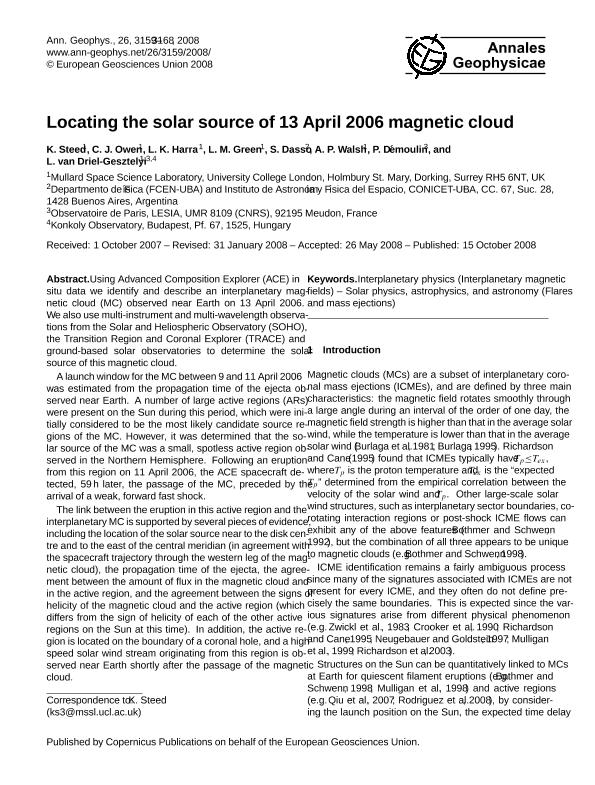Artículo
Locating the solar source of 13 April 2006 magnetic cloud
Steed, K.; Owen, C. J.; Harra, L. K.; Green, L. M.; Dasso, Sergio Ricardo ; Walsh, A. P.; Démoulin, Pascal; van Driel Gesztelyi, Lidia
; Walsh, A. P.; Démoulin, Pascal; van Driel Gesztelyi, Lidia
 ; Walsh, A. P.; Démoulin, Pascal; van Driel Gesztelyi, Lidia
; Walsh, A. P.; Démoulin, Pascal; van Driel Gesztelyi, Lidia
Fecha de publicación:
12/2008
Editorial:
Copernicus Publications
Revista:
Annales Geophysicae
ISSN:
0992-7689
e-ISSN:
1432-0576
Idioma:
Inglés
Tipo de recurso:
Artículo publicado
Clasificación temática:
Resumen
Using Advanced Composition Explorer (ACE) in situ data we identify and describe an interplanetary magnetic cloud (MC) observed near Earth on 13 April 2006. We also use multi-instrument and multi-wavelength observations from the Solar and Heliospheric Observatory (SOHO), the Transition Region and Coronal Explorer (TRACE) and ground-based solar observatories to determine the solar source of this magnetic cloud. A launch window for the MC between 9 and 11 April 2006 was estimated from the propagation time of the ejecta observed near Earth. A number of large active regions (ARs) were present on the Sun during this period, which were initially considered to be the most likely candidate source regions of the MC. However, it was determined that the solar source of the MC was a small, spotless active region observed in the Northern Hemisphere. Following an eruption from this region on 11 April 2006, the ACE spacecraft detected, 59 h later, the passage of the MC, preceded by the arrival of a weak, forward fast shock. The link between the eruption in this active region and the interplanetary MC is supported by several pieces of evidence, including the location of the solar source near to the disk centre and to the east of the central meridian (in agreement with the spacecraft trajectory through the western leg of the magnetic cloud), the propagation time of the ejecta, the agreement between the amount of flux in the magnetic cloud and in the active region, and the agreement between the signs of helicity of the magnetic cloud and the active region (which differs from the sign of helicity of each of the other active regions on the Sun at this time). In addition, the active region is located on the boundary of a coronal hole, and a high speed solar wind stream originating from this region is observed near Earth shortly after the passage of the magnetic cloud.
Archivos asociados
Licencia
Identificadores
Colecciones
Articulos(IAFE)
Articulos de INST.DE ASTRONOMIA Y FISICA DEL ESPACIO(I)
Articulos de INST.DE ASTRONOMIA Y FISICA DEL ESPACIO(I)
Citación
Steed, K.; Owen, C. J.; Harra, L. K.; Green, L. M.; Dasso, Sergio Ricardo; et al.; Locating the solar source of 13 April 2006 magnetic cloud; Copernicus Publications; Annales Geophysicae; 26; 12-2008; 3159-3168
Compartir
Altmétricas



